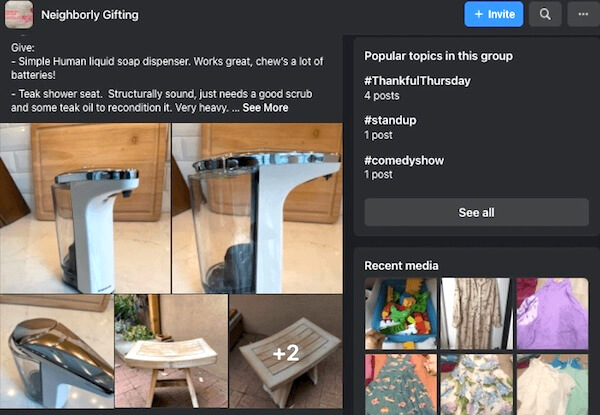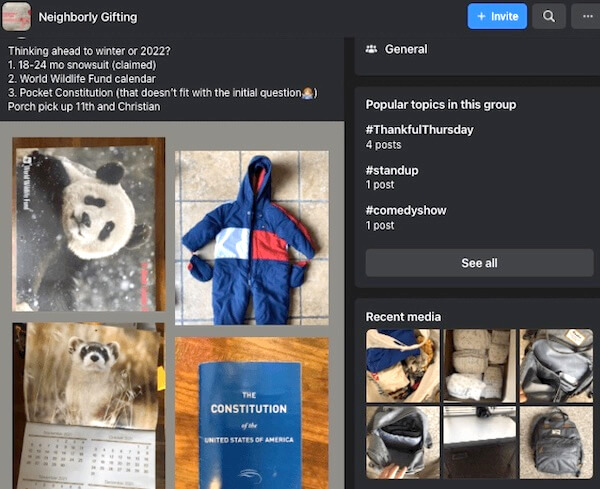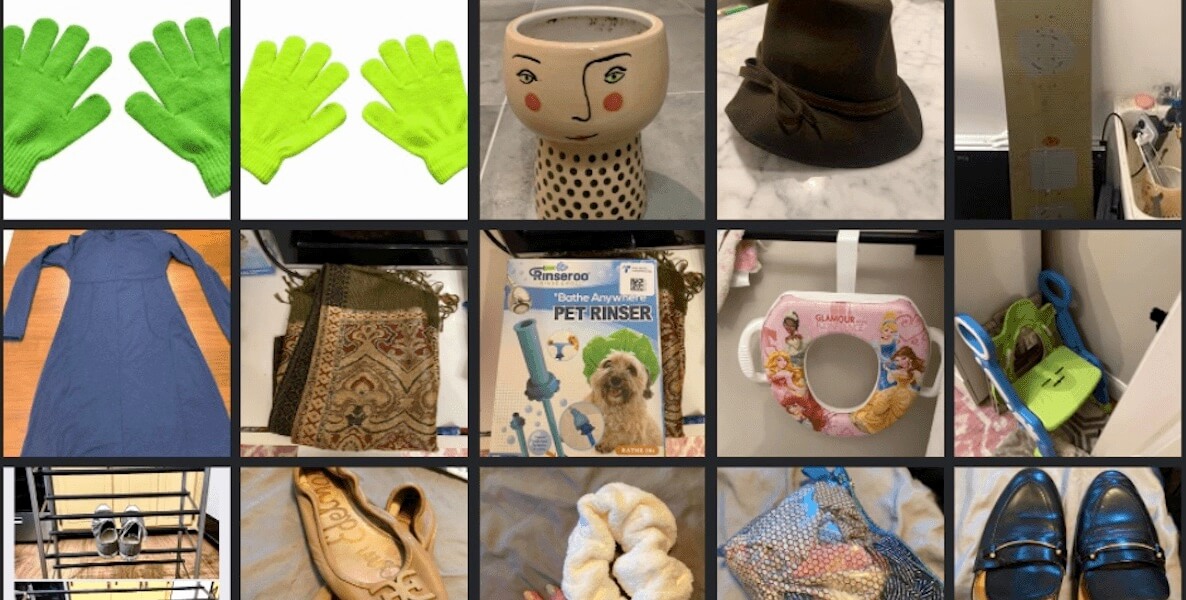Coffee mugs, a queen-size bed frame, a bright blue bike and an unopened jug of Berry Frost Pedialyte—these are some of the many items up for grabs in Philadelphia’s Fairmount neighborhood.
The items—or gifts, rather—are listed on the neighborhood’s Buy Nothing Facebook group page, a hyperlocal offshoot of a worldwide movement that promotes community generosity and recycling. It’s a simple concept: People can post pictures of things they want to give away, and/or requests for items someone else may no longer have a use for. Neighbors give to neighbors—all for free.
Participating in the group is a fast way to give second life to nearly anything that has become clutter in your house—and an incredible way to save money and stop participating in our throw-away culture. And you get to make connections with the people who live around you, which can be more fulfilling than loading up bags and dropping them off at a thrift store.
Participating in a Buy Nothing group is a fast way to give second life to nearly anything that has become clutter in your house—and an incredible way to save money and stop participating in our throw-away culture.
The Buy Nothing project was started in 2013 in Washington by Rebecca Rockefeller and Liesl Clark, who wanted to create a cash-free platform for people to ‘give freely’ and ‘share creatively’ with their neighbors. Each ‘Buy Nothing’ group is hyperlocal, but the overall Buy Nothing community stretches across the globe. Now, Buy Nothing is used in nearly 50 nations, with more than 6,085 Facebook groups—and 44 here in Philadelphia.
… And there’s probably one near you. With the help of Susan Segal, who runs the Fairmount neighborhood Buy Nothing group, we put together this guide with step-by-step tips for:
- How to join your neighborhood Buy Nothing group—and make the most of it
- How to be a good admin for a Buy Nothing group
- How to start a group in your neighborhood
![]()
Joining a neighborhood Buy Nothing group
If you’re not using a Buy Nothing group near you, you’re missing out on a whole lot of free stuff—and building community with your neighbors. Here’s how to join and become a pro at, well, buying nothing.
How do I find a Buy Nothing group near me?
Check out this list of all Pennsylvania groups (including Philly neighborhoods) on the Buy Nothing website. You can also search Facebook or ask your neighbors. (Some areas can also take advantage of the Buy Nothing app, but that’s not available in Philly—yet.)
Apart from neighborhood groups, Buy Nothing also has pages that connect people with similar interests. Buy Nothing Travelers’ Network is a place where you can give and receive items related to traveling from people located along your trip or at your destination (think backpacks, strollers, etc.).
How to join a Buy Nothing group
Some groups will require you to answer a few simple questions to ensure you live within the boundaries of the designated neighborhood and that you don’t already belong to another Buy Nothing group. Your approval may be pending for a few hours, or day (depending on how often the admin checks group requests) before you are accepted.
Tips for giving (and getting!) effectively

Outgrown children’s clothes; kitchen appliances that have gathered dust; packing materials; a half used bottle of shampoo you decided just isn’t working for your hair… anything (legal) is fair game to post. Old or new, to be kept or borrowed.
Take clear, brightly lit photos of the item(s) you want to give away and add a description (make your posts accessible by writing captions to describe images for people who have limited vision). Buy Nothing recommends givers “share stories about themselves, their gifts, and their requests, so that you build deeper connections with your group community.”
Also be sure to tell people how to get in touch if they want the item. Should they comment on the photo or the post? PM (private message) you? (If you post multiple items, it’s helpful to instruct people to comment on the photo of the item that they’re interested in—rather than the entire post.)
The Buy Nothing group works for people in need of supplies just as much as it works for people looking to give things away. If you are searching for an item simply post a request asking if anyone has what you need.
You have full control over what, how, and to whom you want to give your item. Some people give to the first person to comment; some allot a certain amount of time for neighbors to express interest and then draw names; some determine who might be most in need of what they’re offering. It’s 100 percent up to you. You can also decide whether you want someone to pick up the item at your house, drop it off, or meet somewhere in the neighborhood.
The Buy Nothing group works for people in need of supplies just as much as it works for people looking to give things away. If you are searching for an item — a textbook, coffee maker, phone charger, kitchen table — post a request asking if anyone has what you need. (To encourage more requests, some groups designate days to encourage more requests—like “Wish Wednesdays.” Don’t be shy!)
How to become a Buy Nothing admin
Admins are responsible for admitting new members, making sure new and current members adhere to the rules, responding to DMs, and keeping the group friendly and active. If your group has more than one admin, you can decide among yourselves how you want to split up the time commitment.
Susan Segal, co-admin of Buy Nothing, Fairmount, Philadelphia PA with nearly 1,500 members, says she spends about an hour a day managing day-to-day online activity, while her co-admin takes care of new member requests each week.
“There’s a different flavor when you have admins who are very involved,” Segal says. “There tends to be a better feeling; there’s better interactivity.”
“I schedule posts in advance, I respond to people, I read all the messages that come in, and I make comments if I need to,” Segal says. “I probably spent more time than your normal admin just because I’m always in front of my computer.”
She adds that while every group operates differently, groups with active admin seem to have the best experience. So if you want to be a great admin, you’re going to want to be dedicated to the cause. “There’s a different flavor when you have admins who are very involved,” Segal says. “There tends to be a better feeling; there’s better interactivity.”
If you’re interested, respectfully express interest by messaging a current admin on Facebook and playing a friendly and active role in the group until they are looking for a change in admin.
![]()
Starting a Facebook Buy Nothing group
Having trouble finding a Buy Nothing group near you, or wish you had one in closer vicinity to your neighborhood? There’s only one way to go: Start a Buy Nothing group of your own! Here are some suggestions on how to do that.
First, some personal considerations
Do you like social media and problem-solving? Or, are you at least willing to give the tasks a try? Being patient and being online are two of the biggest asks of a Buy Nothing group leader, Segal says.
Educate yourself on Buy Nothing’s goals

After you’ve searched Facebook and downloaded the Buy Nothing app, the Buy Nothing Project encourages admin to take a self-paced online course called ‘The Buy Nothing Academy.” This virtual training comes with seven lessons that walk you through the basics of the Buy Nothing mission and values of giving freely and sharing creatively, how to run your group productively, and how to deal with community conflict if (or when) one arises.
You’ll also learn what a gift economy is and how to build one, and how to better facilitate trusting relationships within the group. Lessons also discuss social justice and diversity in your communities. (If you are a new admin of an already-existing Buy Nothing group, you may be required to take this training too. If not mandated, it could still be a helpful tool.)
Ready? Start your page and spread the word!
Create a Facebook page and name it something simple like “Buy Nothing [Your Neighborhood].” Send your neighbors the link and spread the word through your local newsletter, community bulletin board, community fridge, or Free Little Library.
Establishing rules in your Buy Nothing group
While the Buy Nothing Project has overarching guidelines, you may feel inclined to create a few additional rules or clarifications to best serve your community.
“Some groups allow pets, some groups allow alcohol, some groups allow tobacco,” Segal says. And some do not. “In that respect it’s really up to each group,” she adds.
Her group does not allow business or non-profit promotions, hateful posts, or for group actions outside of the mission. Segal previously dealt with a member who posted about a bike theft, asking the group to help look for the thief. This post fell outside of the guidelines and was deleted, she says.
Clearly describe your group’s goals and rules in the page description, or in a pinned post at the top of your feed.
Clearly describe your group’s goals and rules in the page description, or in a pinned post at the top of your feed.
“If I see a post that goes against our guidelines, I’ll use that as a teaching moment and I’ll post something that says, ‘this is why we do it this,’ or ‘why we don’t do it,’” Segal says.
In your description, tell members what will happen if they break the rules. Will the post be deleted? Will they be suspended from the group? Set boundaries. In the Fairmount group, the most common consequence is to delete a post. If a member persists and gets aggressive, they may be also temporarily suspended, or ‘blocked’ for 30 days.
Utilize the Buy Nothing community at large
“One of the great things about ‘Buy Nothing’ is that because they’re so into helping other people, if somebody on one forum has a specific need, we can reach out to the admins of another group,” Segal says. “Even though we’re separate groups, we still have that connectivity which is really nice.”
Some reasons to reach out to another group could be if someone needs help addressing an emergency like a medical issue, or needs supplies after a disaster, like a house burning down, Segal adds.
Get creative!
Buy Nothing isn’t limited to free ‘things,’ Segal says. In fact, she started a neighborhood knitting group as an offshoot of a Buy Nothing post, she adds.
She encourages others to offer gifts of time or service as well. This could mean offering to drive a person to the grocery store if they are having car problems or running an errand on their behalf.
“That to me is just what this group is all about,” Segal says. “It’s people who come together, because they all want to help, they all want to be a part of something, they like the idea of not throwing things in the trash. It’s such a great warm, enveloping feeling.”
![]()
RELATED




